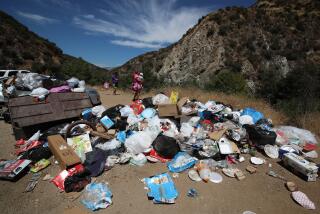Egypt’s Abu Simbel Temples Threatened by Tourists, Birds and Sands
- Share via
ABU SIMBEL, Egypt — Almost 20 years ago, the monumental temples of Abu Simbel were threatened by the rising waters of Lake Nasser, but an international campaign saved them. Now they are threatened again--by tourists swarming over them, birds nesting in them and winds blowing sand against them.
Last year, Egyptian experts had to perform emergency repairs on Abu Simbel’s Great Temple, with its four colossal statues of Pharaoh Ramses II, and the Small Temple dedicated to Nefertari, Ramses favorite queen.
The repairs apparently have curtailed deterioration, but experts now say the birds, blowing sand and--most of all--increasing numbers of tourists are causing new damage every day, challenging the monuments’ very survival.
In October, 32,000 tourists, twice as many as in October, 1986, visited the desolate site 175 miles south of Aswan, site of the high dam that created Lake Nasser.
Tourists Blamed
“Our main problem is humanity,” said Attiya Roudwan, chief antiquities inspector at Abu Simbel. “We have thousands of tourists visiting here every day. Some don’t know how to behave.”
As he spoke, a woman scrambled up a side of the Great Temple to get her camera closer to one of 67-foot-high Ramses colossi.
“Get down from there,” Roudwan shouted to her. “I said, get down.”
After taking one last photograph, the embarrassed tourist clambered back down.
“People don’t realize these temples are built of sandstone and crumble easily,” Roudwan said.
“They also brush without thinking against the beautiful paintings inside the inner temples, some of them with original colors that can easily flake from the walls. Or they just walk up and touch the walls.”
Rescue Effort
From 1964 to 1968, in one of archeology’s most spectacular rescue efforts, the United Nations Educational, Scientific and Cultural Organization sponsored an international effort to save the two 3,200-year-old temples from the encroaching backwater of the Aswan High Dam on the Nile in southern Egypt.
UNESCO also moved 21 other ancient structures from what was to become the bottom of Lake Nasser.
Dignitaries from many walks of life spearheaded the project in a 27-member Committee of Honor formed by UNESCO. They included Princess Grace of Monaco, Eleanor Roosevelt, biologist Sir Julian Huxley of Britain, U.N. Secretary General Dag Hammarskjold of Norway and Emperor Haile Selassie of Ethiopia. All are now dead.
In the $41-million Abu Simbel project, engineers sawed the temples into more than a thousand blocks, averaging 13 tons each, then hoisted them for reassembly onto a ridge 215 feet above. The facades with their monumental statues sliced from a cliff wall were attached to an artificial mountain, a concrete dome with built-in earthquake detectors covering the richly painted temple interiors.
Monuments Patched Up
Roudwan said years of deterioration had worn down the monuments so badly by 1986 that the Egyptian Antiquities Organization had to send 15 restoration experts from Cairo to patch them up.
A critical problem was that the monuments were coming unstuck, the epoxy resin sealer used to cement them seeping out of the joints.
After five months of restoration, repair and cleaning, including extensive work on the face, nose and body of one of the Ramses colossi, the job was done, he said.
Restorer Kamel Attiya Ambaboula, who supervised the restoration, said it generally was successful, but that some problems still await a cure.
“In any such project, we must wait to see how the monuments handle their new environment,” Ambaboula said in an interview at Cairo. “When they were hewn into the mountain, the two temples had stress overhead, but with the new dome they have another situation. There is shrinkage in the (relocated) rocks as the temples reach stability.”
‘Now Stones Can Breathe’
He said the sealer was a problem because epoxy used to bind the blocks was found to be “reacting badly to strong sunlight. We replaced the resin with a cement mortar combined with sand. Now the stones can breathe.”
Birds nest on a row of baboons carved above the Ramses colossi.
“Their droppings contain chemicals that are eating away and discoloring the fragile sandstone,” Ambaboula said. “But what can we do? To clean continually at such heights is a major effort.”
He said aesthetics were largely to blame for damage done by blowing sand and humidity.
“After the temples were moved, landscapers thought it would be a good idea to place layers of sand in front in order to create a nice environment,” Ambaboula said. “Unfortunately, two years later a huge sandstorm hit the area, tossing sand everywhere. We almost lost a face of Nefertari.
Gardeners Made It Worse
“Then we put down grass, but the gardeners didn’t know anything about taking care of monuments. They watered not only the grass but the stone itself and raised the humidity to dangerous levels.”
Ambaboula said he also worries about tourists, especially inside the temples.
“They bring in sand with their shoes, and sand is very abrasive,” he said. “Tourists also stir up dust, which falls onto the (wall) paintings.”
He said some of last year’s restoration efforts should last 50 years. Problems will be evaluated each year, however, because “the temples of Abu Simbel are a top priority for us in Egypt.”
Roudwan maintains the temples symbolize an egotism in Ramses II. The Pharaoh had his artisans carve four monumental statues of himself.
More to Read
Sign up for Essential California
The most important California stories and recommendations in your inbox every morning.
You may occasionally receive promotional content from the Los Angeles Times.










